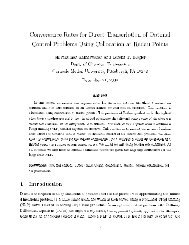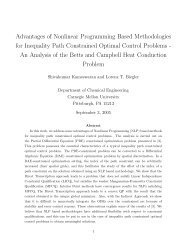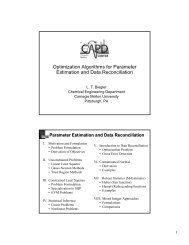6 Case StudiesFrom the results of Sections 3 and 4, we f<strong>in</strong>d that the penalty formulationperforms well, particularly with an active set solver such as CONOPT. With thisexam<strong>in</strong>ation of NLP reformulations for MPCC as well as a systematic strategyfor develop<strong>in</strong>g complementarity formulations, we now consider two large-scalecase studies that illustrate both of these concepts. The first considers discretedecisions <strong>in</strong> dynamic systems with the reformulation of the signum function,while the second considers the disappearance of phases <strong>in</strong> optimization modelsfor distillation.6.1 Dynamic Optimization with Direct TranscriptionThe goal of this case study is to demonstrate the NLP formulations <strong>in</strong> Section 3on an example with arbitrarily many complementarity conditions. The exampleproblem is derived from discretization of a differential <strong>in</strong>clusion (ẋ ∈ sgn(x)+2),where the derivative can be def<strong>in</strong>ed by a complementarity system [29]. While wedo not consider limit<strong>in</strong>g properties of the discretization, our numerical resultswill focus on how the solution time varies as a function of the problem size(controlled by the discretization strategy).The differential <strong>in</strong>clusion can be reformulated as the follow<strong>in</strong>g optimal controlproblem:∫ tendm<strong>in</strong> (x end − 5/3) 2 + x 2 · dt (47a)t 0s.t. ẋ = u + 2 (47b)x = s + − s −(47c)0 ≤ 1 − u ⊥ s + ≥ 0 (47d)0 ≤ u + 1 ⊥ s − ≥ 0 (47e)Apply<strong>in</strong>g the implicit Euler’s method with a fixed step size, the discretizedproblem becomes:NFE∑m<strong>in</strong> (x end − 5/3) 2 + h · x 2 ii=1(48a)s.t. ẋ i = u i + 2 i = 1, . . .,NFE (48b)x i = x i−1 + h · ẋ i i = 1, . . .,NFE (48c)x i = s + i− s − ii = 1, . . .,NFE (48d)0 ≤ 1 − u i ⊥ s + i ≥ 0 i = 1, . . .,NFE (48e)0 ≤ u i + 1 ⊥ s − i ≥ 0 i = 1, . . .,NFE (48f)The result<strong>in</strong>g discretized problem can be scaled up to be arbitrarily large by<strong>in</strong>creas<strong>in</strong>g the number of f<strong>in</strong>ite elements NFE, with a discrete decision <strong>in</strong> each20
element. This system was modeled <strong>in</strong> GAMS and solved via automatic reformulationus<strong>in</strong>g the NLPEC package. Additionally, the GAMS model was convertedto an AMPL model and the problems were solved us<strong>in</strong>g IPOPT-C.This dynamic optimization problem could also be modeled easily as anMIQP. However, f<strong>in</strong>d<strong>in</strong>g a solution is NP-Hard and with an <strong>in</strong>creas<strong>in</strong>g discretization,the problem can become expensive. Solv<strong>in</strong>g this system as an MPCCgenerally leads to only polynomial complexity. On the other hand, the MPCCmodel is nonconvex and global optimality cannot be ensured, although on thisexample a comparison with MIQP solvers showed that global solutions werealways obta<strong>in</strong>ed by the MPCC solver.The discretized MPCC was solved us<strong>in</strong>g the penalty reformulation (PF(ρ)with CONOPT us<strong>in</strong>g ρ = 1000). The results are shown <strong>in</strong> Table 2. It can be seenthat the number of iterations <strong>in</strong>creases almost l<strong>in</strong>early with the number of f<strong>in</strong>iteelements and this behavior is typical for active set strategies. In addition, thecomputational time per iteration <strong>in</strong>creases l<strong>in</strong>early with the number of f<strong>in</strong>iteelements, as the majority of CPU time is expected to be spent <strong>in</strong> the sparsel<strong>in</strong>ear solver. In this case, sparse l<strong>in</strong>ear solvers <strong>in</strong>crease approximately l<strong>in</strong>early<strong>in</strong> computation time with problem size. Consequently, the total computationaltime for CONOPT-PF grows approximately quadratically with problem size.IPOPT-C was also used to solve this problem and the results are shown <strong>in</strong>Table 2. It can be seen that the number of iterations <strong>in</strong>creases only weakly as afunction of problem size, with no clear trend. In fact, the iteration count seemsto saturate with problem size. In addition, the computational time per iterationalso <strong>in</strong>creases l<strong>in</strong>early with the number of f<strong>in</strong>ite elements. This is expected s<strong>in</strong>cethe largest computational cost of IPOPT is due to the l<strong>in</strong>ear solver. Here, thissolver cost <strong>in</strong>creases l<strong>in</strong>early with problem size. As a result, the total computationaltime <strong>in</strong>crease is only slightly superl<strong>in</strong>ear with problem size. Moreover, itis also notable that while CONOPT is faster for the smaller problems, IPOPT-C becomes faster for the larger problems. This is consistent with expectations.CONOPT must also deal with the comb<strong>in</strong>atorial complexity of identify<strong>in</strong>g theactive set at every iteration, whereas the barrier method IPOPT-C identifiesthe active set only at the solution.F<strong>in</strong>ally, the SBB solver, a simple branch and bound solver <strong>in</strong> GAMS, wasapplied to an MIQP formulation of this problem. Here, b<strong>in</strong>ary variables replaceu i <strong>in</strong> every f<strong>in</strong>ite element (48) and correspond<strong>in</strong>g relations are added to reflectthe sign of x i . From the results <strong>in</strong> Table 2, we can observe the NP-hard aspectof solv<strong>in</strong>g the MIQP with this approach. Solv<strong>in</strong>g the problem with 1000 f<strong>in</strong>iteelements requires over 400 CPUs and the problem with 2000 f<strong>in</strong>ite elementscannot be solved with<strong>in</strong> 6000 CPUs.6.2 Distillation OptimizationAs seen <strong>in</strong> Section 5.6, phase behavior of a vapor liquid system is determ<strong>in</strong>edby the m<strong>in</strong>imization of the Gibbs free energy and can be modeled throughcomplementarity constra<strong>in</strong>ts. These conditions allow phase disappearance tobe modeled <strong>in</strong> distillation systems for optimization of both steady state and21






